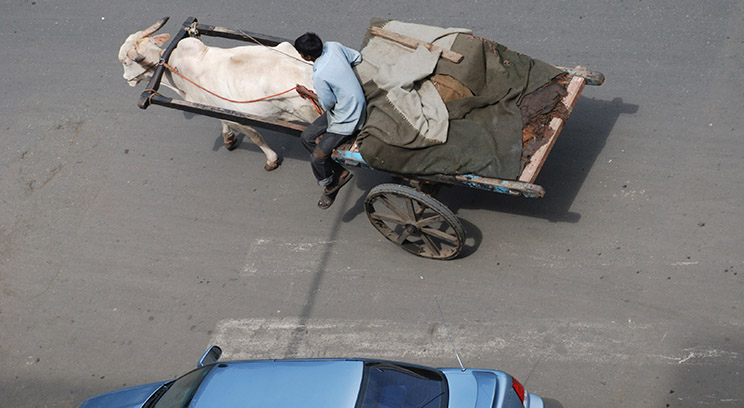Many commentators have described the 21st century as the “Asian Century,” underpinned by the strong rise of China and India. Both countries are undergoing political, economic and social transformation. India is the world’s largest democracy, the second-most populous country in the world, a nuclear-weapon state with one of the world’s largest military forces, and the world’s third largest economy in terms of purchasing power parity. My research agenda focuses on examining changes in Indian politics since the end of the Cold War. I analyze changes observed in the country’s foreign policy since the Cold War years, and in describing India’s case, I attempt to demonstrate how globalization presents opportunities for countries to build strong relations with each other and overcome old hostilities and suspicions.
India’s independence in 1947 coincided with the onset of the Cold War. Having just secured independence from Britain after more than a century of struggle, India was anxious to preserve its freedom of action at the international level. As such, it adopted the doctrine of nonalignment and refused to join either the American or Soviet military alliances. Despite professing nonalignment, India was not averse to developing close relations with either superpower when it suited India’s interests. The choice of nonalignment also dovetailed nicely with India’s decision to adopt a planned economic development model. This resulted in the creation of state-owned enterprises, restrictions on foreign investment and high tariffs on imports, all of which reduced external involvement and influence in India’s economy.
The end of the Cold War forced India to consider the merits of sticking with nonalignment and a planned economic development model in a world where the United States was the sole superpower. Soon afterward, relations with the United States and other Western countries improved dramatically. Formal diplomatic relations were established with Israel and South Africa. At the same time, India attempted to rebuild relationships with traditional rivals China and Pakistan. At home, economic reforms gradually moved India toward a more market-oriented economy. The changes in India’s relations with the rest of the world in the post-Cold War era are best illustrated by looking at India’s relations with its South Asian neighbors.
South Asia broadly includes the countries of Afghanistan, Bangladesh, Bhutan, India, Maldives, Nepal, Pakistan and Sri Lanka. The region is assuming increasing importance in world politics in the post-Cold War era. Its significance has grown considerably since 9/11. It is host to one of the world’s most intractable bilateral disputes, Kashmir, between India and Pakistan. It has a substantial Muslim population residing in Pakistan, India and Bangladesh. It has also embraced economic liberalization programs leading to stronger links with the rest of the world. By virtue of its size and population, India has long been the dominant power in the South Asian region. Maintaining regional supremacy and stability in its South Asian neighborhood and denying the two superpowers a military foothold in the region were key objectives of India’s regional policy during the Cold War. It did this by frequently interfering in the internal affairs of its neighboring countries.
Disagreements over border demarcation, cross-border smuggling, terrorism, illegal immigration and concerns about India’s cultural and economic dominance have tended to cloud the relationship between India and its South Asian neighbors.
However, the end of the Cold War and the onset of a new era of globalization helped create a new world order. Leaders and decision makers were forced to rethink old strategies and security paradigms. Today, as a result of the opportunities and challenges associated with globalization, economic linkages and cooperative security arrangements between countries drive international relations. Countries around the world have attempted to identify shared interests in order to achieve the twin priorities of national security and economic development. The spread of democracy around the world has also been a key development of the post-Cold War period and is seen as one of the positive spinoffs of globalization. The South Asian region is not unaffected by these changes. I have identified three significant developments in South Asia in the post-Cold War era (all of them tied to the process of globalization) that have led India to reorient its relations with its neighbors. These three developments are India’s economic rise, the recent political/democratic transitions in several countries in the region and greater U.S. engagement in the region following 9/11.
All South Asian countries desire to speed up the process of development, taking advantage of the opportunities presented by globalization. The possibility of the establishment of a regional free-trade regime and common market, underpinned by India’s strong economic fundamentals, represents an opportunity for South Asian countries. Trade liberalization at the regional level would likely contribute to national economic growth and development. Economic development is associated with the emergence of a middle class, which desires political rights. This is crucial to the eventual rise of democracy. Trade liberalization fosters democracy, and hence there is a causal link between trade openness and democratic governance. Trade and commercial links not only lower prices and increase choices for consumers but also promote political rights and civil liberties through the transmission of new ideas, tools and technology. The twin goals of development and democratic consolidation for South Asian countries may therefore be achieved through regional trade liberalization, facilitated by India’s economic rise.
In addition, the gradual transition to democracy underway in many South Asian countries is likely to have a positive impact on economic growth and development. Globalization has promoted democratization around the world as democratic ideals trickle across borders on the back of the communications revolution. Democratic transition/democratization is described as the end of the nondemocratic regime, the inauguration of a democratic regime and then the consolidation of the democratic system. As Nobel laureate Amartya Sen pointed out, a democratic political system is crucial to the process of economic development because it helps one understand and fulfill economic needs. Democracies are also unlikely to wage wars against other democracies hence contributing to a more peaceful world. India has chosen to support the democratic transitions in each of the countries of South Asia. The transitions are expected to bring to power previously marginalized groups, which may have an interest in developing good relations with India.
Finally, the 9/11 attacks underscored the significance of globalization. It led to international coalitions battling transnational terror networks in seemingly disparate parts of the world. Post 9/11, the war in Afghanistan and the subsequent insurgency resulted in deeper U.S. engagement with the countries of the South Asian region. This has had an impact on how these countries relate to each other. India’s improving relationship with the United States has made it more confident and less prone to using coercive tactics against its neighbors. There is enhanced cooperation between India and its neighbors in battling terrorism, facilitated in some cases by the United States. Finally, U.S. presence has been cautiously welcomed by India in light of growing Chinese influence in South Asia. At the same time, U.S. presence in the region can be leveraged by smaller countries to check India’s regional aspirations. The political, economic and diplomatic support provided by the United States to some of the smaller countries during the process of democratization has proved invaluable. The United States is helping to develop the rule of law, independent media, grassroots activism, good governance and transparency in these countries – in short, democracy. These are crucial to addressing extremism, security and development in the region.
The three factors are therefore interrelated, and each contributes to the process of economic development and democracy in the region. The end of the Cold War and the ongoing process of globalization have therefore facilitated strong regional ties between the countries of South Asia. A prosperous, peaceful and stable South Asia contributes immeasurably to international peace and security.
Read more from CAS Spotlight.





